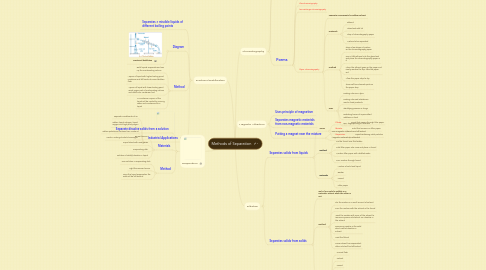
1. Fractional Distillination
1.1. Separates 2 miscible liquids of different boiling points
1.2. Diagram
1.2.1. Fractional distillation
1.3. Method
1.3.1. Both liquids evaporate and rise up the Fractionating column
1.3.2. Vapour of liquid with higher boiling point condense and fall back into round-bottom flask
1.3.3. Vapour of liquid with lower boiling point reach upper part of Fractionating column and distill over condenser first
1.3.4. In condenser, vapour of the liquid will be cooled by running water and condense into a liquid
1.4. Industrial Applications
1.4.1. Separate constituents of air
1.4.2. Obtain liquid nitrogen, liquid oxygen and high-purity argon
1.4.3. Obtain petroleum fractions from crude oil
1.4.4. Used in making alcoholic beverages
2. Evaporation
2.1. Separate dissolve solids from a solution
2.2. Materials
2.2.1. Bunsen burner
2.2.2. Tripod stand with wire gauze
2.2.3. Evaporating dish
2.2.4. Solution of solid(s) dissolve in liquid
2.3. Method
2.3.1. Pour solution in evaporating dish
2.3.2. Light the Bunsen burner
2.3.3. Once the liquid evaporates, the solid will be left behind
3. Magnetic Attraction
3.1. Uses principle of magnetism
3.2. Separates magnetic materials from non-magnetic materials
3.3. Putting a magnet near the mixture
3.3.1. Non-magnetic materials are left behind
3.3.2. Magnetic materials are attracted
4. Filtration
4.1. Separates solids from liquids
4.1.1. Terms
4.1.1.1. Filtrate
4.1.1.1.1. Liquid that passes through filter paper
4.1.1.2. Residue
4.1.1.2.1. Solid that remains on filter paper
4.1.1.3. Suspension
4.1.1.3.1. Liquid containing solid particles
4.1.2. Method
4.1.2.1. Fix the funnel over the beaker
4.1.2.2. Fold filter paper into cone and place in funnel
4.1.2.3. Moisten filter paper with distilled water
4.1.2.4. Pour mixture through funnel
4.1.3. Materials
4.1.3.1. Mixture of solid and liquid
4.1.3.2. Beaker
4.1.3.3. Funnel
4.1.3.4. Filter paper
4.2. Separates solids from solids
4.2.1. Only if one solid is soluble in a particular solvent while the other is not
4.2.2. Method
4.2.2.1. Stir the mixture in a small amount of solvent
4.2.2.2. Pour the mixture with the solvent in the funnel
4.2.2.3. Wash the residue with more of the solvent to remove anymore solid which can dissolve in the solvent
4.2.2.4. Remaining residue is the solid which cannot dissolve in solvent
4.2.2.5. Heat the filtrant
4.2.2.6. Once solvent has evaporated, other solid will be left behind
4.2.3. Materials
4.2.3.1. Conical flask
4.2.3.2. Solvent
4.2.3.3. Funnel
4.2.3.4. Bunsen burner
4.2.3.5. Filter paper
4.2.3.6. Mixture of solids
4.2.3.7. Tripod stand with wire gauze
5. Chromatography
5.1. Invented by M.S.Tswett in 1903
5.2. Isolating colour components of a mixture
5.3. Forms
5.3.1. Liquid chromatography
5.3.2. Gas chromatography
5.3.3. Ion-exchange chromatography
5.3.4. Paper chromatography
5.3.4.1. Separate components by adding solvent
5.3.4.2. Materials
5.3.4.2.1. Ethanol
5.3.4.2.2. Glass tank with lid
5.3.4.2.3. Strip of chromatography paper
5.3.4.2.4. Mixture to be separated
5.3.4.3. Method
5.3.4.3.1. Place a few drops of mixture on the chromatography paper
5.3.4.3.2. Pour a little ethanol into the glass tank and place the chromatography paper in it
5.3.4.3.3. When the ethanol goes up the paper and nearly reaches the top, take the paper out
5.3.4.3.4. Allow the paper strip to dry
5.3.4.3.5. There will be coloured spots on the paper strip
5.3.4.4. Uses
5.3.4.4.1. Finding colours in dyes
5.3.4.4.2. Finding coloured substances used in food products
5.3.4.4.3. Identifying poisons or drugs
5.3.4.4.4. Detecting traces of unpermitted additives in food
5.3.4.4.5. RNA fingerprinting in forensics
